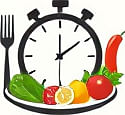Professional Meal Timing Tips
 by Marlene Keeling
by Marlene Keeling
Discover practical strategies for timing your meals to support a busy professional lifestyle. Learn how to prepare nutritious options in advance, whip up quick recipes, and use simple kitchen hacks to maintain energy and health without sacrificing time.

For busy professionals, managing meals effectively can make a big difference in maintaining energy and focus throughout the day. Effective meal timing helps ensure that you fuel your body at the right moments, supporting productivity and well-being.
One key aspect is establishing a routine that aligns with your schedule. Start by identifying your peak energy periods and plan to eat nutritious meals around them. This approach prevents energy dips and keeps you performing at your best.
When it comes to preparing for the week, consider batch cooking as a foundational technique. By setting aside a specific time, such as Sunday evenings, you can prepare several meals at once. This method saves time during weekdays and reduces the temptation to opt for less healthy options. For instance, cooking a large pot of grains like quinoa or vegetables can provide bases for multiple dishes.
Quick recipes play a vital role in this process. A simple option is a vegetable stir-fry that takes under 15 minutes. Begin with chopping fresh veggies like broccoli and carrots, then stir them in a pan with a protein source such as tofu. Season with herbs for flavor, and you'll have a balanced meal ready quickly. Another idea is overnight oats for breakfast; mix oats with yogurt and fruits in a jar the night before, and it's waiting for you in the morning.
Incorporating time-saving kitchen hacks can further streamline your routine. Use tools like a slow cooker to prepare meals with minimal effort. For example, add ingredients in the morning and return to a hot meal in the evening. Organizing your kitchen space also helps; keep frequently used items accessible to cut down on preparation time.
Let's explore some specific meal timing strategies. Aim for three main meals with healthy snacks in between to maintain steady blood sugar levels. For breakfast, eating within an hour of waking can kickstart your metabolism. Lunch should ideally be around midday to sustain afternoon energy, while dinner is best earlier in the evening to allow for proper digestion.
Healthy snacks are essential for bridging gaps between meals. Options like apple slices with nuts provide a quick energy boost without requiring much preparation. Preparing these in advance ensures you always have something on hand.
For those with irregular schedules, flexibility is key. Adjust your meal times based on your workday, but always prioritize balance. Including a variety of food groups in each meal supports overall health.
Now, let's delve into a few quick recipes that fit into a professional's routine. First, a simple salad that assembles in minutes: combine spinach, cherry tomatoes, and chickpeas, then drizzle with olive oil. This dish offers quick nutrients and can be customized with whatever is in your fridge.
Another recipe is a wrap using whole-grain tortillas. Fill it with lean proteins like turkey and add veggies for crunch. It's portable and perfect for eating at your desk during a break.
Kitchen hacks can make these recipes even easier. Pre-wash and chop vegetables ahead of time, storing them in containers for instant use. Invest in a good blender for smoothies, which can serve as a fast meal replacement. Measuring portions in advance also prevents waste and ensures you're eating appropriately sized meals.
Staying motivated is important for long-term success. Track your progress by noting how you feel after implementing these tips, and adjust as needed. Small changes can lead to significant improvements in your daily life.
In summary, by focusing on effective planning and execution, you can integrate these strategies seamlessly. Remember, the goal is to support your professional demands while nurturing your health.
